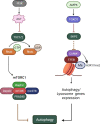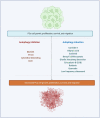Autophagy, a critical element in the aging male reproductive disorders and prostate cancer: a therapeutic point of view
- PMID: 37749573
- PMCID: PMC10521554
- DOI: 10.1186/s12958-023-01134-1
Autophagy, a critical element in the aging male reproductive disorders and prostate cancer: a therapeutic point of view
Abstract
Autophagy is a highly conserved, lysosome-dependent biological mechanism involved in the degradation and recycling of cellular components. There is growing evidence that autophagy is related to male reproductive biology, particularly spermatogenic and endocrinologic processes closely associated with male sexual and reproductive health. In recent decades, problems such as decreasing sperm count, erectile dysfunction, and infertility have worsened. In addition, reproductive health is closely related to overall health and comorbidity in aging men. In this review, we will outline the role of autophagy as a new player in aging male reproductive dysfunction and prostate cancer. We first provide an overview of the mechanisms of autophagy and its role in regulating male reproductive cells. We then focus on the link between autophagy and aging-related diseases. This is followed by a discussion of therapeutic strategies targeting autophagy before we end with limitations of current studies and suggestions for future developments in the field.
Keywords: Aging; Autophagy; Erectile dysfunction; Inflammaging; Male infertility; Prostate cancer.
© 2023. BioMed Central Ltd., part of Springer Nature.
Conflict of interest statement
The authors declare no competing interests.
Figures






Similar articles
-
Semen quality impairment is associated with sexual dysfunction according to its severity.Hum Reprod. 2016 Dec;31(12):2668-2680. doi: 10.1093/humrep/dew246. Epub 2016 Oct 12. Hum Reprod. 2016. PMID: 27733531
-
Traditional Chinese Medicine formula Wubi Shanyao Pills protects against reproductive aging by activating SIRT1/3 to reduce apoptosis.J Ethnopharmacol. 2024 Jan 10;318(Pt B):116976. doi: 10.1016/j.jep.2023.116976. Epub 2023 Jul 29. J Ethnopharmacol. 2024. PMID: 37524234
-
Impact of Metabolically Healthy Obesity in Patients with Andrological Problems.J Sex Med. 2019 Jun;16(6):821-832. doi: 10.1016/j.jsxm.2019.03.006. Epub 2019 Apr 5. J Sex Med. 2019. PMID: 30962157
-
Oral phosphodiesterase type 5 inhibitors and male reproductive potential: an overview.Sex Med Rev. 2023 Jun 27;11(3):240-252. doi: 10.1093/sxmrev/qead010. Sex Med Rev. 2023. PMID: 36990971 Review.
-
Male fertility following spinal cord injury: an update.Andrology. 2016 Jan;4(1):13-26. doi: 10.1111/andr.12119. Epub 2015 Nov 4. Andrology. 2016. PMID: 26536656 Review.
Cited by
-
Radioprotective Effects of Vitamin C, Cimetidine, and Famotidine on Lipid Peroxidase and Hepatic Glutathione Levels in Mouse Liver.Int J Cell Biol. 2025 Jan 4;2025:1106920. doi: 10.1155/ijcb/1106920. eCollection 2025. Int J Cell Biol. 2025. PMID: 39803629 Free PMC article.
-
Reproductive Ageing: Current insights and a potential role of NAD in the reproductive health of aging fathers and their children.Reproduction. 2024 Apr 29;167(6):e230486. doi: 10.1530/REP-23-0486. Print 2024 Jun 1. Reproduction. 2024. PMID: 38471307 Free PMC article. Review.
-
Autophagy and Female Fertility: Mechanisms, Clinical Implications, and Emerging Therapies.Cells. 2024 Aug 14;13(16):1354. doi: 10.3390/cells13161354. Cells. 2024. PMID: 39195244 Free PMC article. Review.
References
Publication types
MeSH terms
LinkOut - more resources
Full Text Sources
Medical

